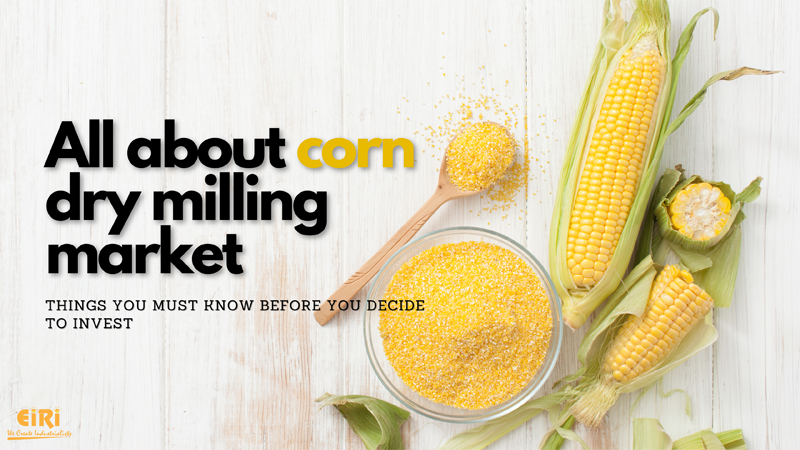Corn Dry Milling – Market Analysis, Opportunities, and Growth
The Corn Dry Milling market is characterised by high production and growing demand for food-grade dry milled corn. The scope of this industry has been growing exponentially as its applications, and industrial demands expand — something that can be owed to changing food consumption trends and, of course, the increasing global population.
That said, Corn Dry Milling products are used in numerous food products developed for consumption such as flours, breads, cereals, breakfast bars and fruit pies; however, the application isn’t just limited to them with dry milling produce also used extensively in pet food, animal feed and ethanol production among many other applications.
For these reasons, it becomes imperative to investigate the market growth and associated opportunities in this sector and pave the way for tapping successfully into the Corn dry milling market both as an investor and an entrepreneur.
First things first, how is Corn Dry Milling Different from Wet Milling?
Simply put, dry milling is the process of grinding kernels into fine flour. This is performed with corn specifically to produce milled corn used in the production of consumer food products.
On the other hand, wet milling involves moistening and softening the corn kernels before grinding them into a fine powder using water and subsequent drying of the processed product to produce powdered corn used in animal feed and ethanol production.
However, what makes the dry milling process more beneficial is its ability to produce high-end food products at an economical rate. As a result, the market continues to grow at a steady pace every year, with 2021 projected to be no different.
The Impact of Covid-19 on the Corn Dry Milling Products Sector
There’s hardly anything in the world that the Covid-19 pandemic hasn’t impacted. The virus has swept across the globe burning and humanity has had to move with the times by adapting to the changes it has brought about.
Among these changes is a change in food consumption habits. Animal protein consumption is on the decline, while veganism and vegetarianism are becoming increasingly common. Corn Dry Milling has also grown exponentially, with producers switching gears to focus more on products for vegan diets.
Contrary to conventional beliefs, food consumption habits are on the rise as well. In fact, the global population continues to grow exponentially in 2021. To make up for this demand, the size of the Corn Dry Milling market has ballooned in recent years, with its value set to soar through the charts in the coming two to three years.
This suggests that consumers are becoming increasingly focused on their diets and are willing to pay for quality products if they exist in the market. As a result, market growth is expected to rise with the expansion of target demographics and the ability of companies to comply with consumer demands.
Corn Dry Milling Products Market: Industry Analysis & Outlook
The corn dry milling products market was sufficing a value of $74.87 billion in 2019 and is projected to reach $88.61 billion by 2022, at a CAGR of 5.5% from 2017 to 2022. The market is driven by the growing demand for food ingredients and their applications across food, beverage, pharmaceutical, agriculture, and biofuel industries.
Food ingredient is the largest application of corn dry milling products. However, with the increasing usage of corn dry milling products in pharmaceuticals and personal care industries, the market growth is expected to be driven by this application domain over the forecast period.
Key indicators of Corn Dry Milling Market Growth
First and foremost, health-conscious consumers are demanding higher quality food products in order to meet dietary needs and reach various fitness goals. The introduction of innovative products based on vegan ingredients is helping manufacturers tap into new markets.
As a result, profit margins in the industry are rising, resulting in higher demand for corn for dry milling. At the same time, the introduction of innovative products based on non-gluten flours has helped companies diversify their product offerings by expanding into niche markets.
Another factor that will affect growth in this sector is a change in consumption habits. The soaring number of vegan and vegetarian diets will influence demand for corn dry milling products, boosting sales over the next two to three years.
Overall, these factors will positively impact the growth of the industry, and its top players will benefit from them. Since they make up a large part of their profits, they are likely to invest more in research and development (R&D); however, that doesn’t mean individuals and SMEs can’t. In fact, small business would have a greater say in the channelisation of the final product into the market. Learn more about the same by ordering a detailed Corn Dry Milling report from us.
The Future of Corn Dry Milling Products
Corn dry milling is a key industry providing raw materials and services to the biopharmaceutical sector. The global demand for corn (both white and yellow) has experienced a marked increase over the past few years as a consequence of biosimilars, traditional biopharmaceutical applications in agribusiness. Recently developed maize cultivars have been specifically developed to meet the requirements of these markets. This will result in further growth prospects for this cluster over the forecast period.




